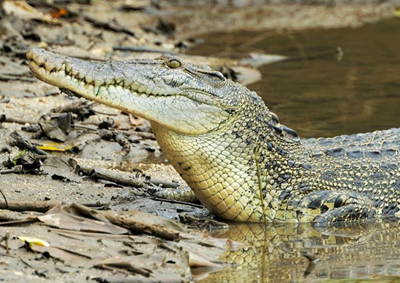What are they?
Crocodiles are large reptiles that can be found in the tropical regions of Asia, Africa, Australia and the Americas. The species that is found here is the Estuarine Crocodile (Crocodylus porosus). Also known as the Saltwater Crocodile, it is the largest crocodile species in the world and can grow to up to 6 to 7 m in length. It has a long snout and a broad muscular tail with ridges.
What should you do if you are in a habitat where crocodiles are found (e.g. mangroves such as Sungei Buloh Wetland Reserve)?

Photo by Mendis Tan
Distribution & Habitat
Estuarine Crocodiles inhabit brackish and freshwater areas such as coastal areas and wetlands. They camouflage well and are difficult to see because they are often submerged in water. Even when out of the water on a river bank, due to the cryptic brown colouration of their skin, they are difficult to spot. They hunt mainly at night, feeding mostly on fish but they may also eat mammals, birds and carrion (the flesh of dead animals).
Estuarine Crocodiles are usually found in the water or on mudflats. Members of public are reminded to take their own safety precautions when engaging in open water activities. Warning signs and advisory notices have been posted at areas where these animals are most often seen, such as Sungei Buloh Wetland Reserve. Exclusion measures, such as fences, have been implemented where necessary to ensure visitor safety. Visitors should heed these signs, which advise the public to stay on visitor routes and not venture off the designated paths.
Behaviour
Crocodiles are cold-blooded and rely on external sources of heat, such as the heat energy of the sun, to warm up. They usually come onto land to bask in the sun. They may look bulky and clumsy but can in fact move very quickly over short distances, both on land and in water. Crocodiles are wild animals and ambush predators that lie in wait for fish or other animals to come close before rushing forward suddenly to attack. They can become aggressive and attack, especially when provoked, whether on land or in water. Females lay their eggs in an elevated mound constructed mainly from mud and each clutch can contain between 40 to 60 eggs. The mothers are fiercely protective of their eggs and young, maintaining a close presence.
Are our green spaces safe to visit?
Estuarine Crocodiles are usually found in the water or on mudflats. Members of public are reminded to take their own safety precautions when engaging in open water activities. Warning signs and advisory notices have been posted at areas where these animals are most often seen, such as Sungei Buloh Wetland Reserve. Exclusion measures, such as fences, have been implemented where necessary to ensure visitor safety. Visitors should heed these signs, which advise the public to stay on visitor routes and not venture off the designated paths.
Did you know?
The species is valued for its hide (quality leather for making shoes and handbags) and meat. Sadly, hatchlings are sometimes sold as pets. Successful captive breeding in crocodile farms, especially in Southeast Asia and Australia, has reduced the hunting pressure on wild populations.
What should you do if you are in a habitat where crocodiles are found (e.g. mangroves such as Sungei Buloh Wetland Reserve)?
- Stay on designated paths and keep away from the water’s edge.
- Do not enter the water.
What should you do if you encounter a crocodile?
- DO stay calm and back away.
- DO NOT approach, provoke or feed the animal.
- Call NParks’ Animal Response Centre at 1800-476-1600 to inform us or for any assistance required
If you have further queries, please contact us through their online feedback form at https://www.avs.gov.sg/feedback.